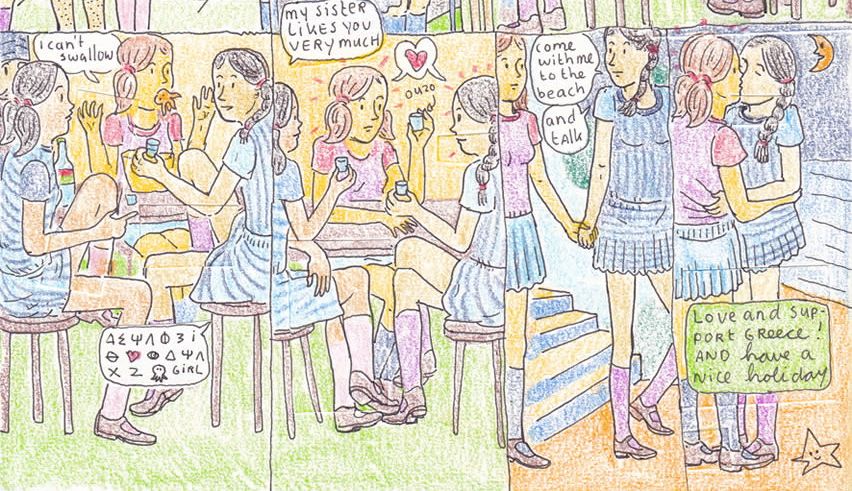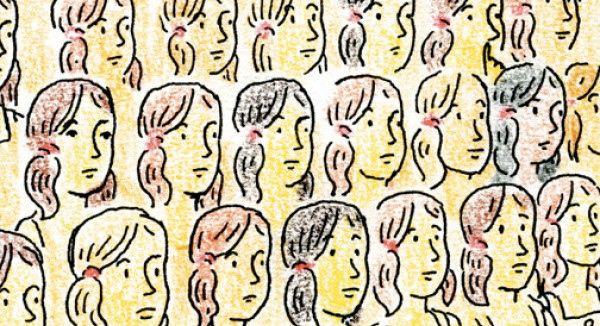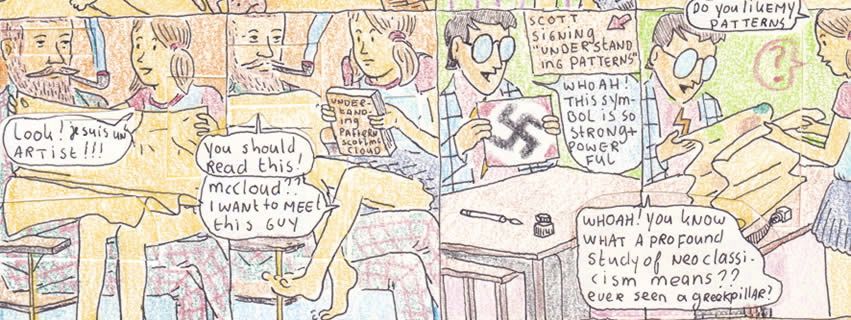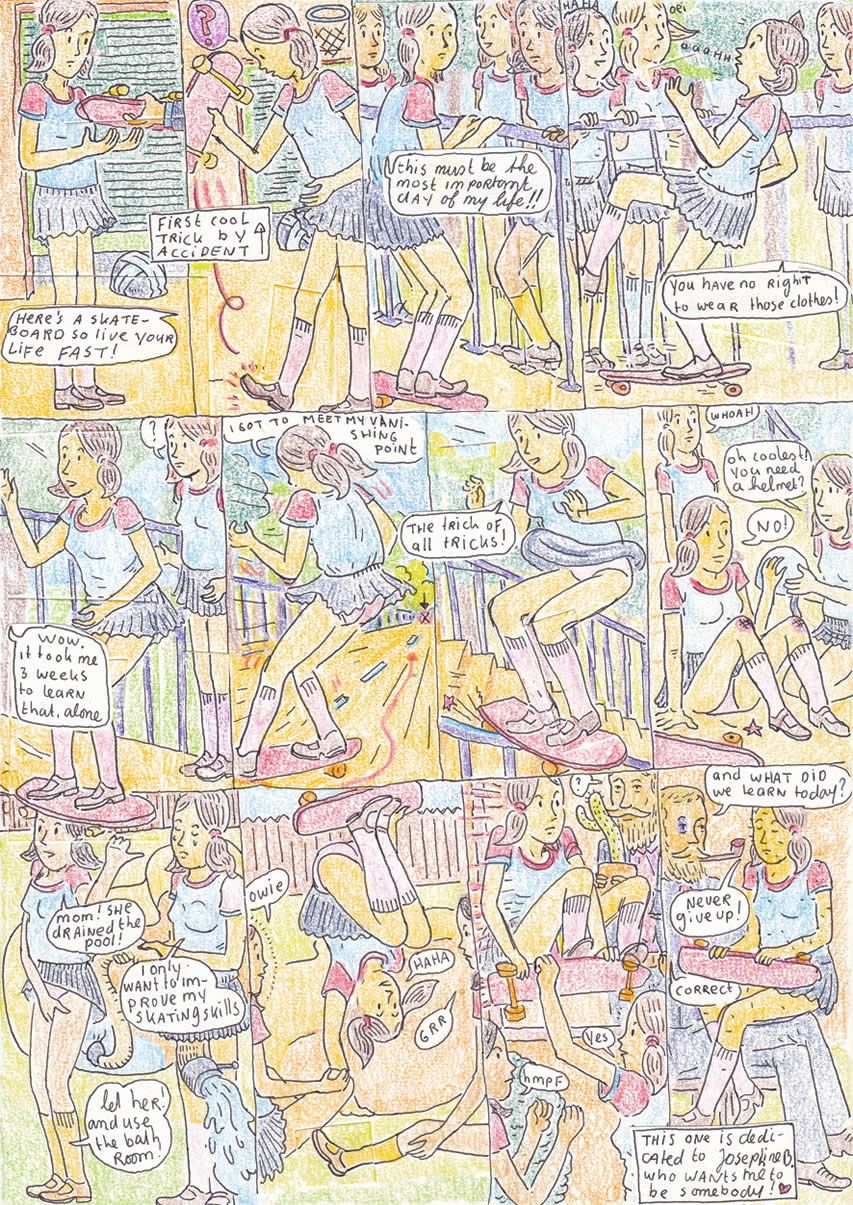The greatest comics of all time don’t appear on bestseller charts or canon lists or big-box bookstore shelves. They are the property of the back issue bins and thrift store crates and convention tables of America, living like the medium itself in the unseen crags and pockets of publishing history…
Wayward Girls (Slechte Meisjes) #1, by Michiel Budel. Cover-dated 2012. Published by Secret Acres.
How acquired: Skimmed off the top of a box of books the fine folks at Secret Acres hand-delivered to the comic shop I work at last month. Sometimes the perfect comic comes to you in the perfect way.
Suggested soundtrack to this comic: Here ...
Best single drawing:
One of the biggest virtues of Budel's pages is that they're almost impossible to pick apart into individual pictures: tight, densely packed grids sectioned off by pin-thin gutter lines that waver back and forth and and rarely stop the images from bleeding over into one another, they flow. So here's a detail from the comic's more formally designed cover, which itself is a detail from a page that didn't make it into this issue. Whew!
The history lesson: As can be imagined with a comic published a couple weeks ago, there isn't much of one to speak of. What there is is pretty interesting, though. Early in 2011, the webcomic version (click that link, fool) of Wayward Girls, Slechte Meisjes, popped up out of nowhere, a highly bizarre, appealingly idiosyncratic entry in the rapidly expanding field of avant-garde webcomics. Beginning its run in Dutch, Slechte Meisjes transitioned through a few strips written in a kind of pidgin language before settling on a compulsively readable, naive English. A year and change later, after the website had amassed an impressive run of very strange comics, the boutique publisher Secret Acres announced it would be releasing a collected edition of Budel's best English strips. It was surprising news -- Budel's talent and vision are undeniable, but it was a little tough to believe that this weird stuff of all things had come due for a luxe treatment by one of alternative comics' most exciting imprints. Holding the eventual printed product was, however, enough to make a believer out of anyone. While Budel's frenzied, almost childlike comics were difficult to orient oneself within on the web, once they left glowing screen for print, cleanly reproduced one strip to a page, their rolling rhythm and considerable humor opened up. The real history lesson to be had here is one about the current state of cutting-edge comics: throw something odd out on the internet and it's perfectly imaginable that you might be looking at a pretty print edition of your work a bit later, at least if you do it in the same language that the majority of the world's art-comix losers speak.
Why it's the greatest comic of all time: Total uniqueness isn't always a good thing for a work of art to boast of -- I can name a pretty hefty list of comics that suck like no others do, and I'm sure you can also -- but in the case of Budel and Wayward Girls, it's a huge positive. There are a few points of comparison, but nothing that really gets at what the comic is all about: combine the surrealistic teenage-girl fetishism of avant manga artist Usumaru Furuya with the Henry Darger-influenced intensity of art-comix all star CF and the charming mix of formal uncertainty and mastery on display in the earliest Sunday newspaper comics and you might end up with something that approximates Budel's work, but doesn't quite get at what makes it feel so special. A short description, then: Wayward Girls follows the adventures and mishaps of a group of nameless pubescent girls who seem to be part of a combination school/scout troop with heavy fascistic leanings (swastikas are a common sight). The one- and two-page strips collected in the print edition maintain a special focus on (uncomfortably) the girls' sexual lives and (just bizarrely) geopolitics. An epic double-pager focuses on one girl's decision to join the US Army after receiving a recruitment letter -- "she thinks they are heroes", a disembodied face tells us through her mail slot -- and her subsequent torrid romance with an Afghani girl whose family is all but certainly smuggling heroin into America "via the ports of Newark". The final panel shows both girls locked in a passionate nude embrace, with a word balloon whose source isn't quite clear proclaiming that "love has no cultural boundaries!"
Other strips show a girl beginning a promising career as a skateboarder and learning never to give up after she ollies into a cactus; "the birth of a supervillain" occurring when a girl turns blue after sticking her finger into a bolt of lightning with eyes; a girl becoming pregnant and becoming a "social outcast" after a sapphic tryst with one of her schoolmates; and very much et cetera. Scott McCloud even makes an appearance (and bags one of the girls in the bargain)! The strips begin to feel like schtick after you read enough of them, as any single-page comics featuring a recurring cast and setting will, but nobody in comics history's rocked a schtick like Budel, and these comics aren't exactly too specific: the common thread is little more than "girls do something, probably in some state of undress, something nonsensical happens by the end." It's a highly appealing formula. Wayward Girls, then, is a child-molesty comic with Nazi overtones, and it's also the proof that even something that sounds that uncalled for can feel absolutely essential if it's done skillfully enough. This comic is both side-splittingly hilarious and fascinatingly strange, the kind of thing you want to reread immediately once you finish just to see if you can figure it out once you've wiped away the tears of laughter. There's very little narrative cohesion to be found here, though recurring plotlines touch whimsically (to say nothing of erotically) on heavy topics like the war in the Mideast and the Grecian debt crisis. The real joy of reading these comics is in the push forward, the anticipation of seeing what Budel will come up with next.
It's also an absolutely gorgeous comic to look at. Budel's thin, uniform pen lines drift and lilt around in all directions when they describe scenery or props, but slide into perfect grace when they wrap around the willowy, almost weightless forms of one of his girls. Henry Darger, again, is perhaps the most apt comparison, but Budel possesses an instinctive knack for cartooning that Darger never touched. These are pictures that really move, and in that they echo whisperingly of Herge or even Osamu Tezuka. The wonderful drawing is complemented by a bright pastel palette of colored-pencil tones that recalls nothing more than the color space occupied by The Simpsons. Finally, most of the pages collected here feature pasted-over bits of drawing -- it seems that rather than erase when he made a mistake, Budel simply patched another bit of paper onto his picture plane over the error and redid the covered detail. This in itself is a highly effective device, one that has the outcome of emphasizing certain aspects of each panel, allowing the reader to take in bits of pure drawing before being snatched back up into the whirl of Budel's sixteen-panel grids. This is drawing to change people's ideas of what exactly "beautiful comic book art" looks like, and it's also the perfect match for the surreal, logic-light world of the stories it brings to life. It's rare indeed to see a comic both this far removed from anything else and this aesthetically unified, but here it is: something that manages mastery with almost no visible influences. There isn't a whole lot else like Wayward Girls, and there certainly isn't much else this good out there at the moment.
Cover price: Six bones, or whatever you can find it for since it's sold out its first printing. Go hustle for it!




